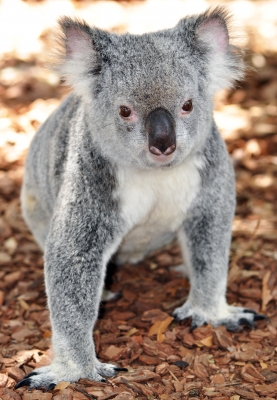Koala
Phascolarctos cinereus
Conservation Status
Australian Government Endangered.
In April 2012, the Australian Government declared the Koala as ‘VULNERABLE’ under the Federal EPBC Act in NSW, the ACT and QLD. Victoria and South Australia were excluded from the listing.
In February 2022 the Koala was listed as ‘ENDANGERED‘ in QLD, NSW and ACT under the EPBC Act.
Species and status overview
The koala is an arboreal marsupial that feeds on the leaves of eucalypts. The koala is endemic to Australia and found on the eastern and southern coastlines of the continent from south Australia to north-eastern Queensland. In Queensland their range also extends inland to the mulga lands, Channel Country, and Mitchell Grass Downs bioregions. Locally several introduced populations occur on islands off the coast of Mackay including Brampton, St. Bees, Newry, and Rabbit.
Koalas are found in a range of woodland habitats in climates that range from semi-arid to temperate to sub-tropical. In this region there are two main populations, one in the Sarina Range and one at Eton, although they were previously much more widespread. Home ranges vary from 100 ha in very dry areas such as central Queensland to as little as 10 ha in coastal areas. They tend to change trees only a few times each day with the exception of dispersing young males who may move several kilometers including crossing disturbed land and roads.
Although koalas feed mainly on eucalypts, they may at times supplement their diet with a range of bloodwood or box species (e.g. swamp box). Across their range they have been observed consuming, or sitting in, up to 120 species of different trees, however they will only consume a portion of these and individual koalas usually limit their diet to one or two key species within their local area. For example, 90% of the diet of koalas on St. Bees Island is Queensland blue gum (Eucalyptus tereticornis).
Koalas can breed at almost anytime of year but large numbers of births over summer and autumn have been observed in some populations. Reproduction is also affected by climatic changes with a considerable reduction in births in drought years (followed by rapid recovery within a few years of the return to non-drought conditions). In the wild, koalas live for 12 (male) to 15 years (female) respectively with breeding beginning around six years of age. One young is born per year and newly born koalas remain in the pouch for around six to eight months. When they emerge they remain dependent on their mother until about 12 months of age.
Koalas have been recorded locally in the following areas
- Sarina
- Middle Creek
- West Plane Creek
- Sarina Range
- Oakenden
- Sunnyside
- Eversleigh
- Pinevale
- Hazeldean
- Brightly
- Koumala
- Clairview
- Eton
- Cannonvale
- Ben Mohr SF
- Gargett
- Dingo Beach
- Peak Downs Highway
- Proserpine SF
- Cathu SF
- Thoopara
- Offshore islands including Newry, Rabbit , Brampton, and St. Bees islands
Description
With variable grey coloured fur, a stocky body, and large round ears, the koala varies in size with larger (12 kg) animals found in the south around Victoria, and smaller animals (6.5 kg), with shorter fur, in the north.
Koalas have relatively poor vision and rely more on their keen sense of hearing and smell. Their sense of hearing is necessary for socialisation and vocalisation between animals. Their call is distinctive and varies from the distinctive male bellow most often heard during the mating season to low grunts and squeaks. The low frequency of the bellow sound means it can travel long distances and through dense vegetation. Their refined sense of smell assists them to differentiate between leaf species, including toxicity, and to detect scent markings of other koalas.
Koalas are superbly adapted for life in the canopy. Their paws are adapted for gripping and climbing with both front and hind paws having opposable digits and rough pads to aid grip. Their limbs are long and muscular, and their thigh muscle joins the shin much lower than in other mammals, which provides additional strength.
While a koala’s diet of eucalypt leaves is high in dietary fibre, it has a low nutritive value and high toxicity. The koala receives only a small amount of energy from its diet and tends to sleep for up to 20 hours a day. Their waking hours are mainly spent feeding and minimal energy is wasted on socialising or aggressive behaviours.
The koala’s closest living relative is the common wombat.
Conservation concerns
In Queensland a national assessment of koala populations (1990 – 2010) estimated that numbers had declined 43% in 20 years, from 295 000 in 1990 to 167 000 by 2010.
Known threats include
- Habitat loss and fragmentation
- Vehicle strike
- Predation by domestic and wild dogs
- Altered fire regimes
- Exacerbation of habitat loss and modification by climate change.
- Diseases such as chlamydia (which reduces fertility) and Koala Retrovirus (possibly responsible for a range of conditions including leukaemia and immunodeficiency syndrome). Note: Impacts of disease are regionally dependent and infection does not necessarily lead to mortality.
- Climate change – warmer and drier conditions forecast across part of their range will cause range contraction. Increased atmospheric CO2 will cause eucalypt leaves to lose protein and increase tannin – reducing their quality as a food source.
- Previous broad-scale hunting for the fur trade
What can I do?
- Consider your clearing options in areas of koala fodder trees. Avoid clearing or aim to retain tree-patch connectivity of these areas to reduce predation and disease spread.
- Control domestic and wild dogs on your property
- Maintain suitable grazing regimes that allow some tree regeneration in paddocks. Fence off areas of trees to allow recruitment of seedlings.
- Implement suitable fire regimes to maintain koala habitat.
Resources
Biocollect App for Koala Mapping
Further information
National Koala Conservation and Management Strategy 2009-2014
ALA
Photo credit Michelle Meiklejohn
